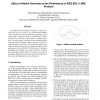Free Online Productivity Tools
i2Speak
i2Symbol
i2OCR
iTex2Img
iWeb2Print
iWeb2Shot
i2Type
iPdf2Split
iPdf2Merge
i2Bopomofo
i2Arabic
i2Style
i2Image
i2PDF
iLatex2Rtf
Sci2ools
LCN
1998
IEEE
1998
IEEE
Effect of Hidden Terminals on the Performance of IEEE 802.11 MAC Protocol
The hidden terminal problem is unique to wireless networks and as of now, there is very limited understanding about it's effects on network performance. Results are presented from a simulation study of the IEEE 802.11 MAC protocol when operating in the presence of hidden terminals. We also propose a framework for modeling hidden terminals which can handle complex scenarios of both mobility and static obstructions. Our simulations indicate that hidden terminals can have a very detrimental effect on the performance of the IEEE 802.11 MAC protocol. Although throughput is acceptable when about 10 percent of station pairs are hidden, packet delay can increase by an order of magnitude. Performance of the protocol drops sharply when the number of hidden pairs exceeds 10 percent.
Related Content
| Added | 05 Aug 2010 |
| Updated | 05 Aug 2010 |
| Type | Conference |
| Year | 1998 |
| Where | LCN |
| Authors | Sumit Khurana, Anurag Kahol, Anura P. Jayasumana |
Comments (0)

